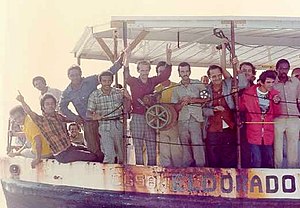| Part of the Cuban exodus | |
 Cuban refugees arriving in crowded boats during the Mariel boatlift crisis in 1980 | |
| Date | April 15 – October 31, 1980 (6 months, 2 weeks and 2 days) |
|---|---|
| Also known as | Exodo del Mariel (English: Mariel exodus) |
| Participants | Government of Costa Rica Government of Cuba Government of Peru Government of United States People from Cuba People from Haiti |
| Outcome | Around 125,000 Cubans and 25,000 Haitians arrive in the United States. |
The Mariel boatlift (Spanish: éxodo del Mariel) was a mass emigration of Cubans who traveled from Cuba's Mariel Harbor to the United States between April 15 and October 31, 1980. The term "Marielito" is used to refer to these refugees in both Spanish and English. While the exodus was triggered by a sharp downturn in the Cuban economy, it followed on the heels of generations of Cubans who had immigrated to the United States in the preceding decades.
After 10,000 Cubans tried to gain asylum by taking refuge on the grounds of the Peruvian embassy, the Cuban government announced that anyone who wanted to leave could do so. The ensuing mass migration was organized by Cuban Americans, with the agreement of Cuban President Fidel Castro. The Cuban government considered the exodus a sort of social cleansing of the nations' so-called undesirables and as organized acts of repudiation against prospective emigrants.
The arrival of the refugees in the United States created political problems for U.S. President Jimmy Carter. The Carter administration struggled to develop a consistent response to the immigrants. The Mariel boatlift was ended by mutual agreement between the two governments in late October 1980. By then, an estimated over 125,000 Cubans had reached Florida.